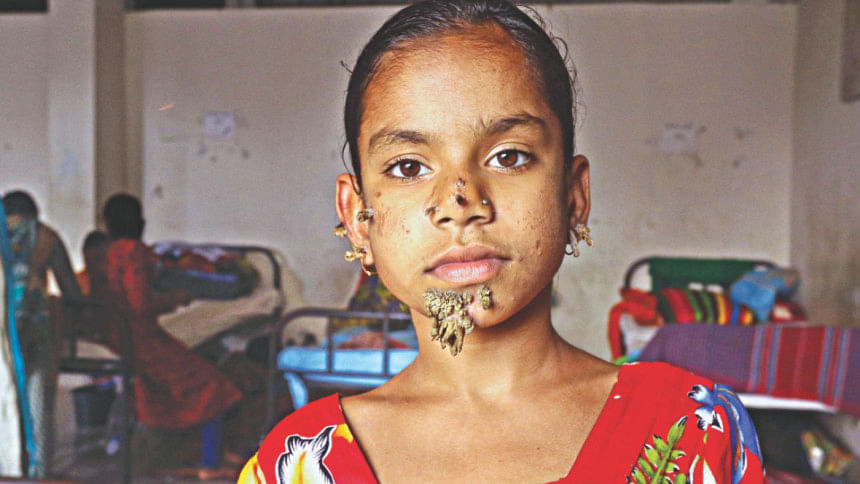10-year-old girl feared to have 'tree man' disease

Prickly rashes were first seen on Shahana Khatun's face when she was only a year old. Her parents thought it was nothing serious and would vanish.
The rashes were almost of the same size until she turned six. Then those began to grow and spread raising the alarm but not to the extent that her father Shahjahan Mia, of Baluchara village in Netrakona sadar, would promptly take her to a doctor.
He talked to villagers and pharmacy retailers but no one seemed to have any idea.
In the next two years, similar rashes grew over ear and right leg knee. Frantically, Shahjahan took Shahana to a homeopathic doctor in late 2015.
The girl took medicines for a month, but nothing changed.
“I got totally frustrated. Meantime, a teacher and a local journalist told me to bring Shahana to Dhaka,” the father said.
Shahjahan, a poor farmer, finally acted on that when he learnt treatment at Dhaka Medical College Hospital (DMCH) would be free of cost.
He borrowed Tk 650 from a relative and came to the hospital, the father said at the burn unit of DMCH where 10-year-old Shahana was admitted early this week.
“This appears to be similar to “tree-man” disease that affected Abul Bajandar of Khulna,” said Samanta Lal Sen, national coordinator of burn services in Bangladesh.
Shahana is the first female who could have contracted the disease, he said.
A six-member medical board will be formed today to assess her illness, Samanta Lal said. “We will treat her free of cost.”
Previously, Abul Bajandar, 26, was operated on at least 18 times at the hospital to remove bark-like warts from his limbs.
He has been suffering from epidermodysplasia verruciformis, a rare skin disorder commonly known as tree-man illness, which covers limbs with warts, making them look like tree branches.
Bajandar, believed to be the fourth man in the world with the illness, is expected to be fully cured. He needs four to five more surgeries, Samanta Lal said.
SOCIAL STIGMA
Meanwhile, Shahana has been unhappy about going to school in the last one year because, her father said, her classmates at Baluchara Government Primary School don't want to mingle with her.
That upset 35-year-old Shahjahan who saw his daughter grow up without her mother Nasima Begum after her death four years ago. Since then she has been raised by her grandmother Safia Khatun.
“When I went to school, some of my classmates didn't come close to me. They said I had horns, which might spread to them,” said Shahana, a student of class-III, at DMCH burn unit.
“Shahana is perfectly alright in learning lessons, sporting and even in work,” her father told The Daily Star.
Now that doctors at DMCH assured him of treating her for free, he feels immensely relieved.
“I am hopeful that Shahana will be fine soon,” Shahjahan said.
According to DermNet New Zealand, a resource about skin diseases, epidermodysplasia verruciformis (also called Lewandowsky-Lutz dysplasia) is an extremely autosomal recessive inherited disorder. Till date, no cure has been found.
A Romanian man was first diagnosed with the disease in March 2007. Another case was reported in Indonesia in November that year in a 35-year-old fisherman.
The last reported case in 2009 also happened to be in Indonesia. The Indonesian fisherman died on January 30 last year from the complications related to his condition as the warts began to reappear. Those were surgically removed earlier.

 For all latest news, follow The Daily Star's Google News channel.
For all latest news, follow The Daily Star's Google News channel. 



Comments